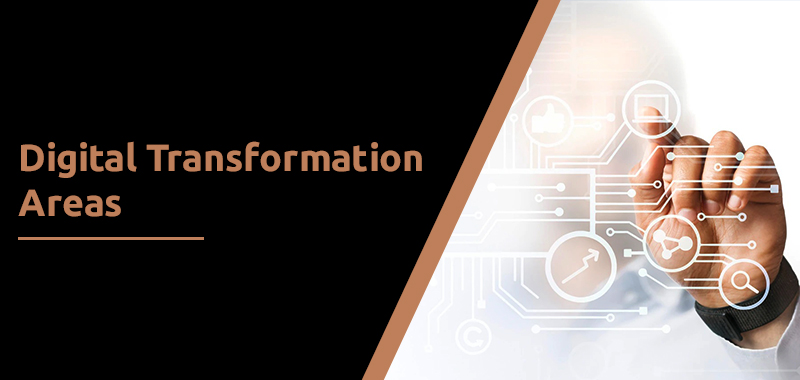Smart integration of digital technologies, processes, and competencies across all levels and functions in a phased and purposeful manner results in the cultural, organizational, and operational change of an organization, industry, or ecosystem (also see digital transformation strategy). As a leading software development company, we are explaining digital transformation, why it’s important, and factors to consider in detail.
Digital Transformation (also known as DX or DT) uses technology to innovate and build the capacity to quickly adapt to changing conditions for various stakeholders (customers in the broadest sense).
In order to fully capitalize on the changes and opportunities brought about by a variety of digital technologies and their accelerating impact across society, business and organizational activities, processes, competencies, and models must undergo a profound digital transformation. This transformation must be strategic, prioritized, and keep both the present and future in mind.
Customer behavior and expectations, new economic realities, societal shifts (such as aging populations), ecosystem/industry disruption, and (the accelerating adoption and innovation regarding) emerging or existing digital technologies are just a few of the factors that can contribute to the need for faster deployment of a digital transformation strategy.
Customer Experience:
The development of new revenue streams and information-powered ecosystems of value, along with the optimization of the entire customer experience from start to finish, are key drivers and goals of digital transformation in practice. These efforts also result in new business models and digital processes. Prior to reaching there, it’s important to address internal issues as well, such as those involving outdated systems and process disconnects, as internal objectives are unavoidable for the following phases.
Building the right bridges (between front end and back office, data from “things” and decisions, people, teams, technologies, various players in ecosystems, etc.) in the function of that journey is crucial to success. Digital transformation is a journey with multiple connected intermediary goals, ultimately striving towards ubiquitous optimization across processes, divisions, and the business ecosystem of a hyper-connected age.
Read more about: What is Digital Transformations?
The human element is crucial to it on many levels, including in the aims of digital transformation and obviously in the stages of transformation as such (collaboration, risk management, ecosystems, skills, culture, empowerment, etc.). There will always be an “offline” component because people don’t want “digital” for everything and value personal and face-to-face connections, depending on the situation. However, digital transformation also affects non-digital interactions and transactions in the sense that it empowers every employee or agent that interacts with customers.
A DX strategy attempts to develop the capacity for fully utilising the potential and opportunities of new technologies and their influence in the future in a faster, better, and more creative manner. Beyond silos and internal/external constraints, a digital transformation journey requires a tiered approach with a defined plan, including a range of stakeholders. This roadmap takes into account the reality that the final objectives will alter over time because, in practice, digital transformation is a continual process along with change and digital innovation.
Digital Transformation Areas:

In the integrated and connected sense that it requires, digital transformation can, among other things, touch upon the transformation of:
Business Activities or Functions:
Marketing, operations, human resources, administration, customer service, etc.
Business Process Management:
Business process optimization and business process automation are three terms used to describe the connected operations, activities, and sets that make up a business process in order to achieve a certain business goal (with new technologies such as robotic process automation). Business process optimization is crucial to digital transformation initiatives, and in the majority of businesses and situations, it combines internal and customer-facing objectives today.
Business Models:
Describe how businesses work, from the value proposition and go-to-market strategy to the ways they try to make money and successfully transform their core businesses by utilising new revenue sources and strategies. In some cases, they even abandon their traditional core businesses.
Business Ecosystems:
Include networks of partners and stakeholders as well as external influences on the company, such as economic or regulatory agendas and changes. On the foundation of the digital transformation, information, and new ecosystems connecting businesses with different backgrounds are developed where data and useful insight become assets for creativity.
Asset Management for Business:
Wherein traditional assets are prioritised, but less “tangible” assets like information and customers are also given more attention (improving the customer experience is a key objective of many “projects” of digital transformation, and information is the foundation of all business activities, technological advancements, and interpersonal interactions). Customers and information must both be considered actual assets from all angles.
A Company’s Culture:

The acquisition of key competencies across the board in areas like digital maturity, leadership, knowledge worker silos, and so on, that enables one to be more future-proof is achieved by having a clear customer-centric, agile, and hyper-aware aim. Processes, commercial activities, cooperation, and the IT side of digital transformation all intersect with culture. Changes are needed in order to sell applications more quickly. Development and operations make up DevOps’ fundamental components. Change is necessary for IT and OT to function together in enterprises, processes, and activities (it’s not just about information and operational technologies; it’s about processes, culture, and teamwork). Etc.
Models for Ecosystems and Partnerships:
A growth in cooperative, collaborative, co-creative, and, last but not least, completely new business ecosystem techniques, which result in new company models and revenue sources. Ecosystems will be crucial to the success of digital transformation and the as-a-service economy.
Approaches from clients, employees, and partners.
Technology comes second to people and strategy in the digital revolution. Any stakeholder’s evolving behavior, expectations, and demands are essential. Customer-centricity, user experience, worker empowerment, new workplace models, shifting channel partner dynamics, etc. are just a few change subprojects where this is reflected. It’s crucial to remember that digital solutions are never the only way to address any of these human concerns, from improving customer experience to increasing worker satisfaction. In the first place, individuals involve, respect, and empower other people; technology is an extra enabler and a component of the equation of choice and basic requirements.
Ending:
It is advantageous that Nettyfy Technologies provides a novel method for enhancing the efficiency and accuracy of an IT project. Contact us so we can finish your project successfully.
